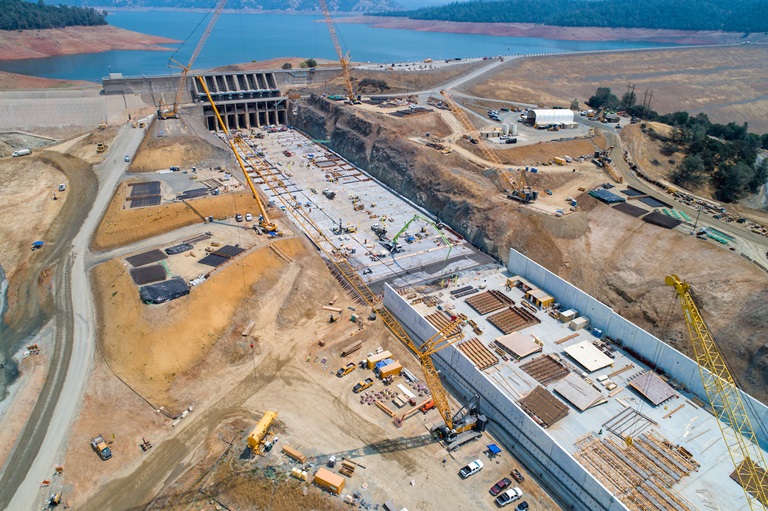Sustainable Techniques Bring Concrete Results: Making DWR Infrastructure Carbon-Friendly
A drone provides an overview of the upper chute on the Lake Oroville main spillway in Butte County. Photo taken August 2, 2018.
With Governor Newsom’s recent pledge to invest $8 billion in water infrastructure, carbon-friendly concrete is increasingly in the mix in the Department of Water Resources’ (DWR) infrastructure projects. This includes efforts to modernize California’s largest water delivery system, the State Water Project (SWP).
“Cement is a key component of concrete and a significant contributor to greenhouse gas emissions, so minimizing the impact cement can have on our environment is important,” said Joe Royer, Branch Manager for Geotechnical Services for DWR’s Division of Engineering. “Most emissions from traditional cement production result from chemical reactions in the manufacturing process.”
The cement industry produces about 7% of carbon emissions globally (about double the emissions from global air travel). Over half of these emissions are from the chemical alteration of materials during production. The remaining emissions are from the burning of fossil fuels to generate the high temperatures needed to make concrete.
To make cement, crumbly ingredients known as clinker are an important part of the recipe. One commonly used filler is limestone formed from calcium carbonate heated at very high temperatures - up to 2,820 degrees Fahrenheit. However, the process changes the chemistry of the limestone and adds carbon into the atmosphere. Recent data shows that carbon dioxide emissions from cement manufacturing have doubled in the past 20 years to nearly 2.9 billion tons of carbon dioxide.
Now, a less carbon-intense material is catching on as way to offset the climate impact of concrete. Some SWP sites are returning to a Portland cement substitute known as pozzolan. Sourced from volcanoes, pozzolans provide a partial replacement of cement in concrete and can reduce CO2 pollution by approximately 15.5 percent.
“Natural pozzolans are a substitute for Portland cement,” Joseph Burke, Dams and Canals Unit Supervisor at DWR, said. “The manufacture of Portland cement produces about 0.9 pounds of CO2 for every pound of cement. By using natural pozzolans, the total Portland cement content is reduced by 15 to 20 percent in concrete.”
One example of carbon-friendly concrete in action includes DWR construction that took place at Oroville Dam. America’s tallest dam, Oroville can hold about 3.5 million acre-feet of water. The repairs used low-carbon concrete, resulting in 125 pounds per cubic yard of less cement and reduced about 2,037 tons of carbon dioxide. This is equal to removing the emissions of 400 gasoline-powered vehicles over one year.
“At Oroville, we were able to create a green concrete mix and then share within the department what worked, and specification guidelines that others can follow,” said Giovanna Vera, a Dams and Canals Engineer. “We discovered that the slabs placed with the 'greener concrete' cracked less and we were able to conclude that the redesigned concrete mixes were not only 'greener', but they were also more durable.”
In another example of DWR’s carbon-friendly concrete use, the Big Notch habitat restoration and fish passage project in Yolo County includes a carbon-friendly concrete mix.
Through this sustainable concrete approach, California moves closer to its goal of net-zero emissions from the cement sector by 2045. It also helps the state manage the impact of climate change. In 2017, the state passed the Buy Clean California Act, which sets limits on the global warming potential for public works projects. DWR also encourages the contractors it works with to use sustainable concrete in DWR projects.
“Oroville Dam provides a good example of how this can work. Its use of a substitute material for cement to make a high-quality concrete also creates less carbon emissions,” said Royer.
